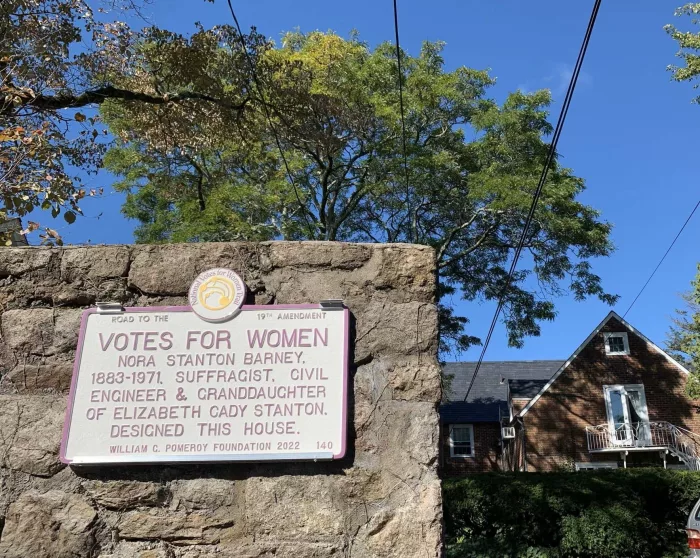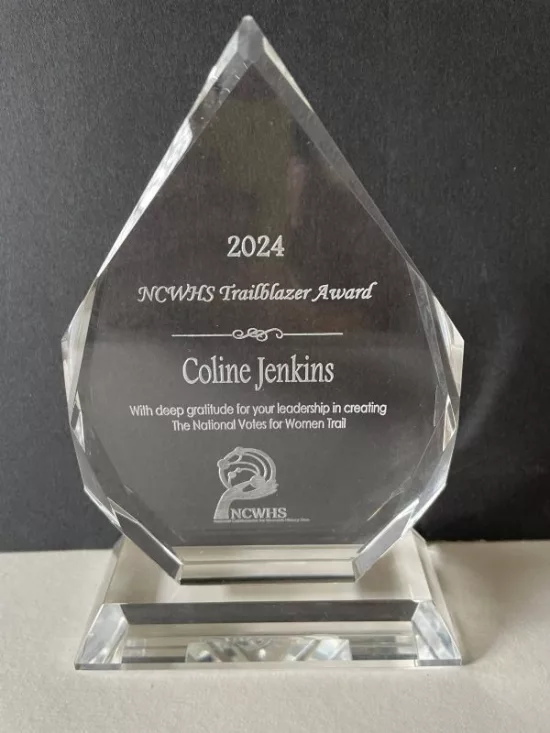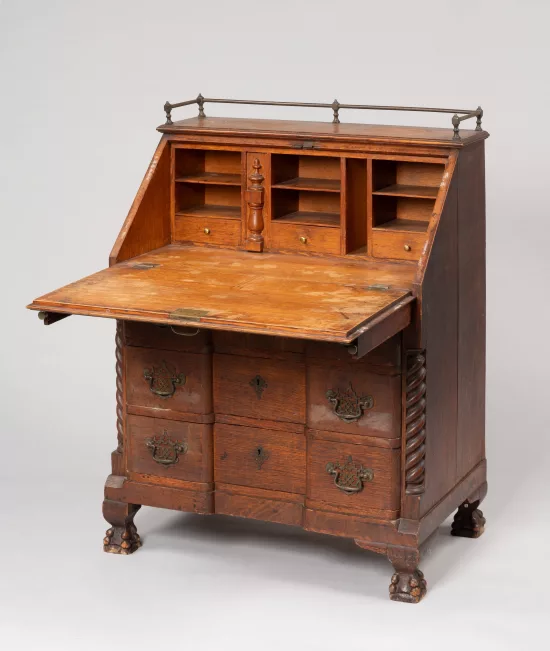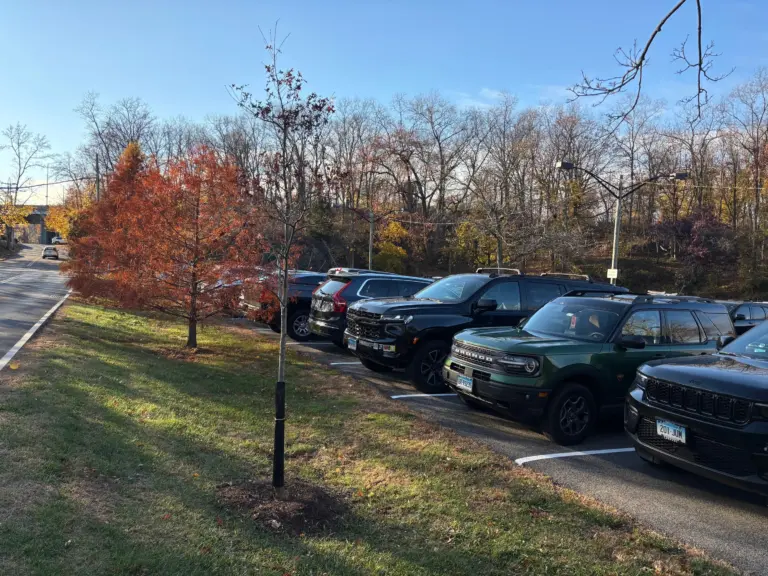
By Anne W. Semmes
Coline Jenkins of Old Greenwich is being celebrated this Women’s History Month by the National Collaborative for Women’s History Sites for her pioneering role in helping to establish a national trail of historical roadside markers citing the women’s rights movement. There is one outside her historic family house on Steamboat Road that spells out her notable ancestry as the great, great granddaughter of Elizabeth Cady Stanton, “one of America’s foremost leaders in the women’s suffrage movement.”
Those are Jenkins’ own words that she spoke in 2008 before the U.S. Senate at a hearing arranged by then U. S. Senator Hillary Rodham Clinton to testify in favor of a Senate bill 1816 for “the creation of a women’s rights history trail.” As president of the Elizabeth Cady Stanton Trust, Jenkins had been called upon by Clinton. And it was at the historic 1848 Women’s Rights Convention in Senaca Falls, NY that Stanton “rose to the dias and spoke these words, ‘We hold these truths to be self-evident that all men and women are created equal…’”
That alteration of the Declaration of Independence to include women is to be featured as part of the 250th celebratory exhibit of “The Declaration’s Journey” at The Museum of the American Revolution in Philadelphia opening this October. On exhibit will be the desk of Elizabeth Cady Stanton as loaned by Jenkins, whereupon Stanton wrote the “Declaration of Sentiments” that included those words, “all men and women are created equal.”
“The most important thing is the journey of the Declaration,” says Jenkins. “It isn’t that the Declaration was just written in Philadelphia in 1776 – end of story. It’s a journey through a nation, through history, through laws, through activism. So, it’s a fascinating journey, and my family is a part of that journey…and I’m very honored to be part of it.”
Jenkins grew up visiting that house on Steamboat Road, where her mother Rhoda Jenkins, an architect, lived and her suffragist grandmother Nora Stanton Barney, a pioneering civil engineer. “They were very active building houses and being socially active, politically active.” She visited Seneca Falls as a teenager and seen Elizabeth Cady Stanton’s house. “But through my lifetime,” says Jenkins, “My mother and I helped in any way we could with the interpretation of the house’s history or the photographs. And then eventually it became a National Park.”
She recalls a memorable event of reading a book called “Eighty Years And More,” reminiscences of Elizabeth Cady Stanton. “It’s not really an autobiography…its online, you can read it. And when I read it, it was like putting on an old shoe. It fit perfectly, it just felt very comfortable. I was learning about her by being with my grandmother and my mother. Those values were coming down, how women were viewed.”
In her married life Jenkins became a representative of the RTM some 30-plus years ago where she remains a member, now heading District 6 in her Old Greenwich neighborhood. It was there her awareness of how women were viewed became apparent in one of her first acts, a resolution that would make the language of the Greenwich government “gender inclusive…It passed with only three of 230 dissenting.” She’s learned with all this women’s history, “It takes time to change things.”
But she’s managed to make a bold imprint with sculptures of her ancestor. Her efforts were successful for the return of the “Portrait Monument,” a long-forgotten statue of Stanton and fellow suffragists Susan B. Anthony and Lucretia Mott to the Capitol Rotunda in Washington in 2000. Then as vice-president of Monument Women there was that “breaking of the bronze ceiling” with the first sculpture of females – “Monument to Suffrage Pioneers” – added to Central Park in 2020. Jenkins tells the tale.
“It was the one hundredth year of the passage of the 19th Amendment. But the idea was conceived in 2013. A couple were walking through Central Park visited by 42 million people, and they’re looking at all the statues of a lot of great men…And then there was Alice in Wonderland and Mother Goose females. But where are the women? Which is a good question to ask everywhere. And so, they called me to ask if I knew anything about Elizabeth Cady Stanton?” Thus, an organization called “Where Are the Women” was created that brought into being a statue featuring Stanton, Susan B. Anthony, and Sojourner Truth. “And so, it was a very long process, but it was a successful process.”
With all these accomplishments what is Jenkins most proud of? “I helped to spread the knowledge. For instance, there’s something called History Day, a nationwide competition in schools where they set a theme. This year they set rights and responsibilities. So, I’ve heard from Nebraska, Delaware, New Jersey kids calling me up from 8th to 12th grades, and they compete to learn history. And so, I try and spread this history because I think it’s very good for women and men and girls and boys.”
Looking back at Elizabeth Cady Stanton’s young life she says, “She was unmarried. She was smart, but there were no colleges open to her. No professions or professional education. She’s doing stuff with no pay. She can’t serve on a jury; she can’t run for office. She cannot vote…My life is so much better. Not only my life, but many American lives are so much better, and we’re a stronger nation for that.”
But then we have yet to have a woman President? She has a surprising, if hopeful, response. “Well, I am telling you that on my gravestone, I have engraved, ‘I saw the first female president of the United States.’ How are you not recognizing the talents of 51 percent of the population where they’re more women than men. How can you basically deny something based on gender? And I believe in merit. But I can’t believe that we’ve had a nation for 250 years and never have elected a leader that’s female. It just doesn’t make sense to me.”
“So, it’s a fascinating journey, and my family is a part of that journey…and I’m very honored to be part of it.” Coline Jenkins.






